Michigan is a heaven for bird enthusiasts, offering a diverse array of avian species. Whether they call it home year-round or migrate seasonally, black and white birds add a touch of elegance to Michigan’s natural landscapes. Today, we’ll explore some of the most popular species that captivate birdwatchers. Get ready for a delightful journey!
Table of Contents
List of Black and White Birds in Michigan
Black-capped Chickadees

Colouration and recognition: One of the highlights of identifying these black and white birds in Michigan is their easily distinguishable features. They have a small black cap and beak, white cheeks, and a grey body with a slightly lighter underside. Black-capped chickadees are adorably compact and petite.
Distribution and habitat: These birds can be found in the northern regions of the United States, including Michigan, as well as the southern parts of Canada. They consider these areas their permanent homes. Look for them in habitats with tall trees and listen for their distinctive calls.
Nesting: Black-capped chickadees construct their nests in small natural cavities or create their own nesting sites. When using nesting boxes, they prefer wood shavings and sawdust as nesting materials. Their nests can be as high as 20 meters, although they are typically around 7 meters above the ground.
Related Article: A Collection of 12 Rare Birds in Ohio (Accompanied by Images)
Dark-eyed Juncos
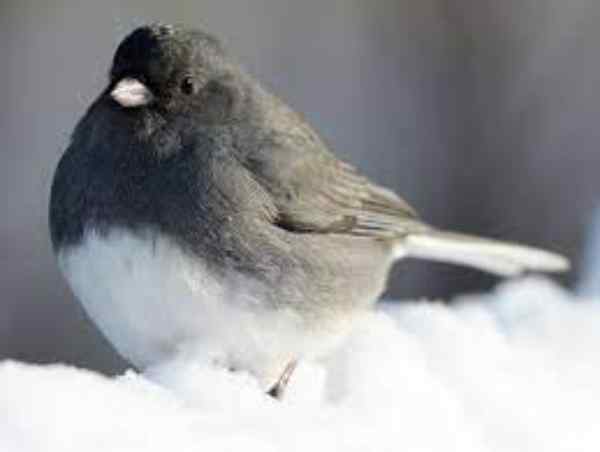
Colouration and recognition: Dark-eyed juncos are remarkable birds that inhabit the forest floors of the western mountains. Their appearance is truly captivating. With a dark grey head that gradually transitions to a white belly, they are a feast for the eyes. These small and round birds have pitch-black eyes.
Distribution and habitat: These delightful avian creatures can be found in the northern parts of Michigan, where they have established their permanent habitat. During the breeding season, they migrate further north and can also be spotted in the southern regions of Michigan.
Nesting: Juncos prefer nesting in close proximity to the ground. Their chosen nesting spots, which are not exclusively selected by females, are often found amidst tangled roots of upturned trees or sloping ground. In populated areas, they may even nest inside or beneath buildings.
Eastern Kingbirds
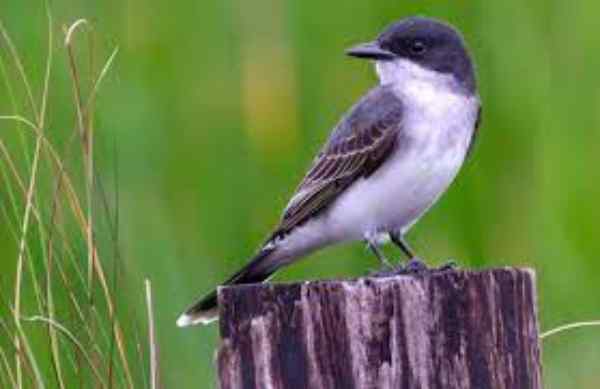
Colouration and recognition: The dominant colours of Eastern kingbirds are dark grey and white. Their elegant appearance is enhanced by a long dark beak that harmonizes with their black eyes and dark grey head. The combination of white and grey body markings gives them the appearance of wearing a stylish business suit.
Distribution and habitat: To spot this bird in the Michigan area, keep an eye out near forest edges, on top of wires, or along fences. Their distinctive electric call is well-known. It’s important to note that Eastern kingbirds only visit Michigan during their breeding period.
Nesting: An intriguing aspect of Eastern kingbirds is that the female is solely responsible for building the nest, which takes about two weeks. However, the male can play a role by influencing the selection process to some extent.
Related Article: A Collection of 12 Charming Small Grey Birds With White Bellies
Loggerhead Shrikes

Colouration and identification: The loggerhead shrike is a small songbird with a fierce appearance, characterized by a long tail. Its body is adorned with a combination of soft grey and white colours, creating a striking visual effect. The black eyes of the bird are further emphasized by the black markings around them, giving it the appearance of wearing a mask.
Distribution and habitat: The United States provides an ideal habitat for loggerhead shrikes. They primarily reside in the central and southern regions of the country throughout the year. However, during their breeding period, they migrate to the northern parts, including Michigan.
Nesting: Both male and female loggerhead shrikes work together to find the perfect nesting spot. It may take them some time to locate a suitable location, and once found, they typically spend about 6-11 days constructing the nest collaboratively.
Black-billed Magpies

Coloration and identification: The black-billed magpie is a fascinating and visually striking bird, known for its captivating black and white plumage. Its underbelly is white, while the upper parts and tail are adorned in black. Adding to their allure, their long wing feathers exhibit a unique pattern of being half-white and half-black. Black-billed magpies are also recognized for their sociability and vocal nature.
Distribution and habitat: Due to their vocal nature, black-billed magpies are relatively easy to spot, particularly perched on fence posts and trees. If you’re seeking the opportunity to observe these magnificent birds, North Michigan is the ideal location to do so.
Nesting: When it comes to choosing nesting sites, black-billed magpies are not particularly selective and can make use of various locations ranging from abandoned buildings to deciduous trees. Interestingly, both the male and female magpies collaborate in building the nest together. However, if they cannot agree on a suitable spot, they may construct separate nests in different locations.
Downy Woodpeckers
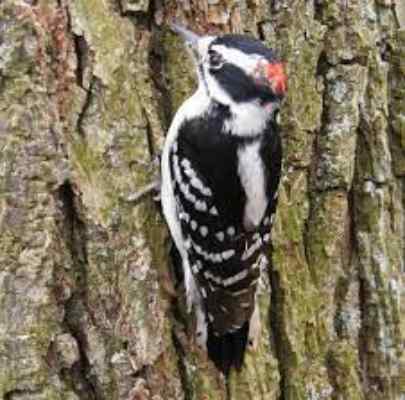
Colouration and identification: The downy woodpecker is a familiar sight in backyard settings, being the most prevalent woodpecker species. It features a distinctive, pointed beak and is renowned for its black and white striped head, adorned with a vibrant red patch on its back. The back and wings showcase a predominantly black hue, adorned with small white markings, while the belly is a pristine white.
Distribution and habitat: Downy woodpeckers are widespread throughout the Michigan region, making it their year-round home. They are commonly found nesting and are easily observable even in residential areas.
Nesting: A noteworthy characteristic of downy woodpeckers is their preference for nesting in either dead trees or the decaying portions of live trees. They create small nest cavities, a process that typically takes around one to three weeks to complete.
Blackpoll Warblers
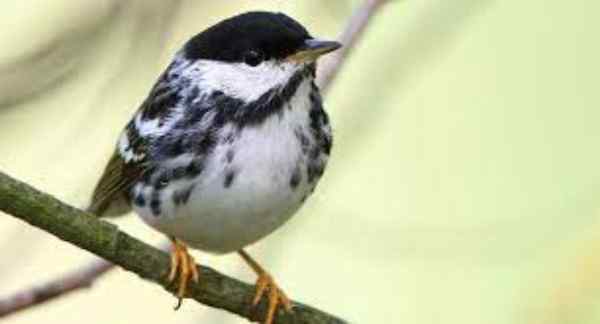
Colouration and identification: The male blackpoll warblers exhibit a striking colouration with white cheeks and a black head, accompanied by a pointed beak, which sets them apart. In contrast, females display more subdued hues, such as dark grey and brown, and possess a less pointed beak. Both genders sport a touch of orange on their legs.
Distribution and habitat: When in the Michigan region, blackpoll warblers are frequently observed moving in groups. The optimal time to spot them is during the spring or fall, as they migrate to northern areas for breeding purposes.
Nesting: Blackpoll warblers favour nesting in fir trees. It is the female’s responsibility to seek out the nesting site, and once she locates it, she does not employ any additional materials to construct the nest. The height of their nests can range from 15 centimetres to 9 meters.
Carolina Chickadees

Colouration and identification: The Carolina chickadee, a charming and friendly bird, displays an appealing contrast of black and white colours. Its spherical shape adds to its distinctiveness and makes it a delightful sight to behold. The cheeks of this bird are pure white, while the top of its head is black.
Distribution and habitat: These tiny black and white birds can be found in a variety of habitats, including woodlands, swamps, open woods, parks, and residential areas. While the Carolina chickadee is predominantly located in North and South Carolina, you may also have the chance to spot it in the southern regions of Michigan. They can be found there throughout the year.
Nesting: Carolina chickadees have a preference for creating or utilizing existing tree cavities for nesting. Both the male and female chickadees work together to construct their cosy nest within the cavity. Interestingly, they do not exhibit any particular preference when it comes to the type of sawdust used.
White-breasted Nuthatches
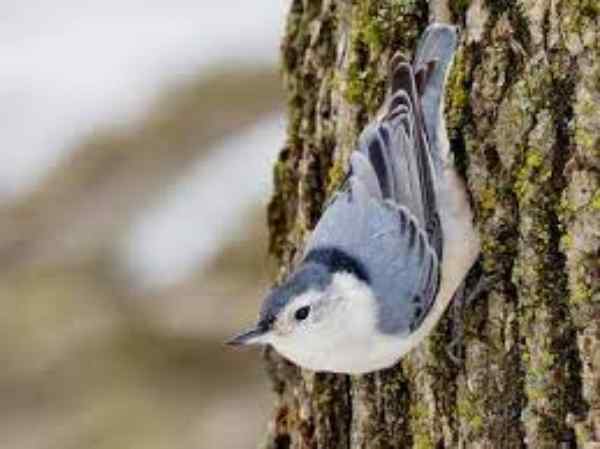
Colouration and identification: The white-breasted nuthatch possesses a unique elegance that sets it apart from other birds. Its black, white, and grey feathers complement its remarkably long and pointed beak, despite its small size. Additionally, these black and white birds are renowned for their boisterous vocalizations.
Distribution and habitat: With a population of 10 million, white-breasted nuthatches are widely distributed across various regions. They can be found not only in Michigan but also throughout the United States and beyond. To observe these black and white birds, explore open areas with large trees, as they tend to frequent such environments.
Nesting: While white-breasted nuthatches are capable of excavating their own cavities, they typically prefer to locate existing woodpecker-made nests. The female nuthatches take charge of constructing the nest, utilizing dirt and bark clumps, which they line with fine grass and feathers to create a cosy space for their offspring.
Related Article: Black Birds with Yellow Beaks: 11 Illustrations to Explore
Hairy Woodpeckers
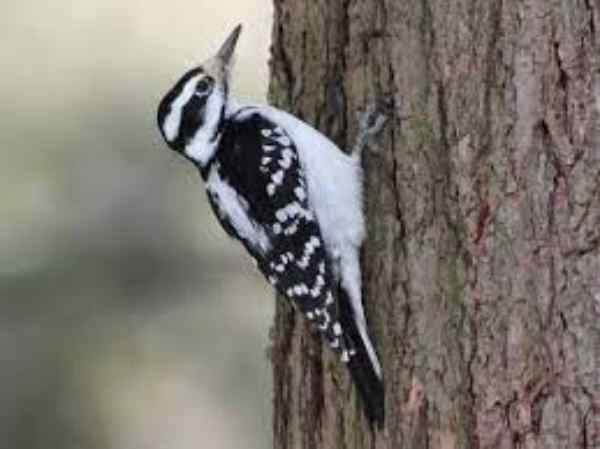
Colouration and identification: Although resembling the downy woodpecker we previously described, the hairy woodpecker can be differentiated by its slightly sturdier and slender beak. In terms of colour, the hairy woodpecker exhibits the same hues as the downy woodpecker.
Distribution and habitat: Hairy woodpeckers are permanent residents across the entirety of the United States. They do not engage in migration or breed in other regions. Additionally, these woodpeckers can be found in Canada and are present in a variety of settings, including suburbs, parks, and woodlands.
Nesting: Hairy woodpeckers exhibit a preference for deceased trees when selecting their ideal nesting site. To protect their space from potential squirrel intrusions, they construct their cavities with an entrance hole positioned on the underside.
Final Words
It’s time to wrap up the list of black and white birds in Michigan, and we can’t forget to mention the stunning black-capped chickadee. This small bird has striking black and white plumage, and it’s no wonder it’s spotted on almost half of the birdwatching lists.
But don’t fret if you haven’t caught a glimpse of this particular species yet, as there are plenty of other black and white birds to spot in Michigan. With persistence and a keen eye, you’re bound to discover some of these beautiful feathered creatures on your next birdwatching adventure.
Reference:
- https://birdspecies.org/black-and-white-birds-in-michigan
- https://www.allaboutbirds.org/guide/Black-and-white_Warbler/id
- https://birdweb.org/birdweb/bird/white-crowned_sparrow
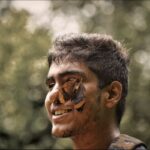
Jeevan Kodiyan
An animal enthusiast with an interest in zoology, studying the behavior and activities of animals in the wild habitat. I work on research projects related to species conservation and endangered species protection. I also leverage zoology to become an educator, educating others about the importance of protecting our natural environment and the beauty of animals in their natural habitats.









